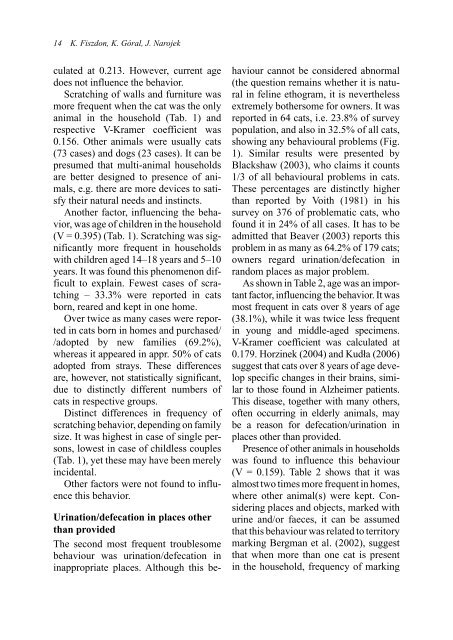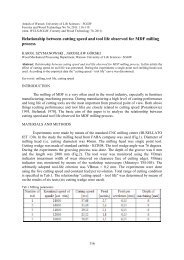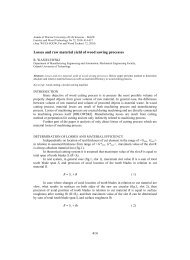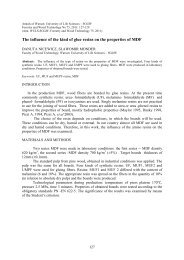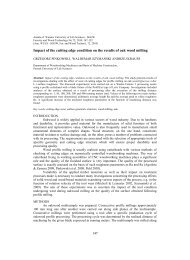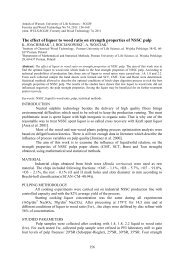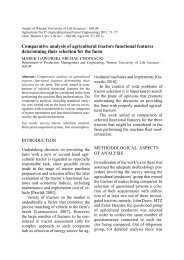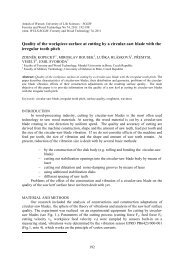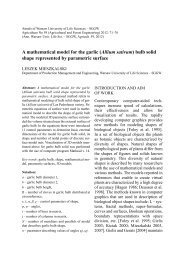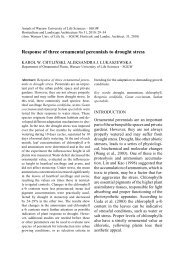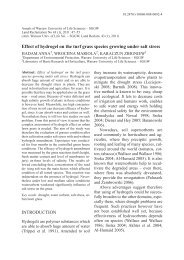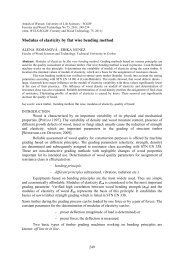Annals of Warsaw University of Life Sciences – SGGW. Animal ...
Annals of Warsaw University of Life Sciences – SGGW. Animal ...
Annals of Warsaw University of Life Sciences – SGGW. Animal ...
Create successful ePaper yourself
Turn your PDF publications into a flip-book with our unique Google optimized e-Paper software.
14 K. Fiszdon, K. Góral, J. Narojek<br />
culated at 0.213. However, current age<br />
does not influence the behavior.<br />
Scratching <strong>of</strong> walls and furniture was<br />
more frequent when the cat was the only<br />
animal in the household (Tab. 1) and<br />
respective V-Kramer coefficient was<br />
0.156. Other animals were usually cats<br />
(73 cases) and dogs (23 cases). It can be<br />
presumed that multi-animal households<br />
are better designed to presence <strong>of</strong> animals,<br />
e.g. there are more devices to satisfy<br />
their natural needs and instincts.<br />
Another factor, influencing the behavior,<br />
was age <strong>of</strong> children in the household<br />
(V = 0.395) (Tab. 1). Scratching was significantly<br />
more frequent in households<br />
with children aged 14<strong>–</strong>18 years and 5<strong>–</strong>10<br />
years. It was found this phenomenon difficult<br />
to explain. Fewest cases <strong>of</strong> scratching<br />
<strong>–</strong> 33.3% were reported in cats<br />
born, reared and kept in one home.<br />
Over twice as many cases were reported<br />
in cats born in homes and purchased/<br />
/adopted by new families (69.2%),<br />
whereas it appeared in appr. 50% <strong>of</strong> cats<br />
adopted from strays. These differences<br />
are, however, not statistically significant,<br />
due to distinctly different numbers <strong>of</strong><br />
cats in respective groups.<br />
Distinct differences in frequency <strong>of</strong><br />
scratching behavior, depending on family<br />
size. It was highest in case <strong>of</strong> single persons,<br />
lowest in case <strong>of</strong> childless couples<br />
(Tab. 1), yet these may have been merely<br />
incidental.<br />
Other factors were not found to influence<br />
this behavior.<br />
Urination/defecation in places other<br />
than provided<br />
The second most frequent troublesome<br />
behaviour was urination/defecation in<br />
inappropriate places. Although this behaviour<br />
cannot be considered abnormal<br />
(the question remains whether it is natural<br />
in feline ethogram, it is nevertheless<br />
extremely bothersome for owners. It was<br />
reported in 64 cats, i.e. 23.8% <strong>of</strong> survey<br />
population, and also in 32.5% <strong>of</strong> all cats,<br />
showing any behavioural problems (Fig.<br />
1). Similar results were presented by<br />
Blackshaw (2003), who claims it counts<br />
1/3 <strong>of</strong> all behavioural problems in cats.<br />
These percentages are distinctly higher<br />
than reported by Voith (1981) in his<br />
survey on 376 <strong>of</strong> problematic cats, who<br />
found it in 24% <strong>of</strong> all cases. It has to be<br />
admitted that Beaver (2003) reports this<br />
problem in as many as 64.2% <strong>of</strong> 179 cats;<br />
owners regard urination/defecation in<br />
random places as major problem.<br />
As shown in Table 2, age was an important<br />
factor, influencing the behavior. It was<br />
most frequent in cats over 8 years <strong>of</strong> age<br />
(38.1%), while it was twice less frequent<br />
in young and middle-aged specimens.<br />
V-Kramer coefficient was calculated at<br />
0.179. Horzinek (2004) and Kudła (2006)<br />
suggest that cats over 8 years <strong>of</strong> age develop<br />
specific changes in their brains, similar<br />
to those found in Alzheimer patients.<br />
This disease, together with many others,<br />
<strong>of</strong>ten occurring in elderly animals, may<br />
be a reason for defecation/urination in<br />
places other than provided.<br />
Presence <strong>of</strong> other animals in households<br />
was found to influence this behaviour<br />
(V = 0.159). Table 2 shows that it was<br />
almost two times more frequent in homes,<br />
where other animal(s) were kept. Considering<br />
places and objects, marked with<br />
urine and/or faeces, it can be assumed<br />
that this behaviour was related to territory<br />
marking Bergman et al. (2002), suggest<br />
that when more than one cat is present<br />
in the household, frequency <strong>of</strong> marking


